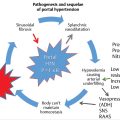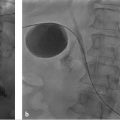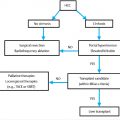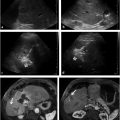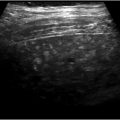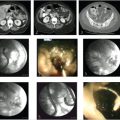28 Obesity and Bariatric Embolization
Charles Y. Kim
28.1 Introduction
Recently, the interventional radiology literature has included reports about treating obesity with an endovascular method that involves the disruption of ghrelin secretion. 1 This procedure entails percutaneous transarterial embolization of the gastric fundus, which is the site of the highest concentration of ghrelin-secreting cells in the body. Because the left gastric artery serves as the predominant supply to the gastric fundus, this artery has been targeted in a number of studies, and as such this procedure has been referred to as “left gastric artery embolization.” However, because other arteries to the gastric fundus may also be embolized and because the left gastric artery is often embolized for the treatment of acute gastric bleeding, the term “bariatric embolization” has been introduced to more accurately describe this procedure when performed specifically for the treatment of obesity. Embolization of the gastric fundus has been shown to decrease serum ghrelin levels in animals and induce relative weight loss. 1 Because ghrelin is the only hormone known to cause hunger, it is hypothesized that decreasing serum ghrelin levels may decrease hunger and food intake, thereby inducing weight loss. This chapter will review the clinical significance of obesity, the pathophysiology of hunger, and the existing preclinical and clinical data on bariatric embolization for the treatment of obesity.
28.2 Obesity
Obesity has become one of the most concerning and growing health problems in the world. In 2008, more than 1.4 billion adults were overweight, with a body mass index (BMI) of 25 or greater. A total of 500 million were obese, with a BMI of 30 or higher. 2 Thus, 11% of the world′s population met the criteria for obesity. The rate of obesity is growing, with an incidence that has nearly doubled since 1980. In 1997, the World Health Organization (WHO) designated obesity as a global epidemic. 3 This marked the first time in history that a noninfectious entity was labeled as an epidemic, which emphasizes the increasing prevalence of obesity and its critical effect on global health. 3
The health implications of obesity are vast. Obesity is ranked as the fifth leading risk for mortality globally and has been strongly linked to numerous comorbidities, including type 2 diabetes, hyperlipidemia, hypertension, obstructive sleep apnea, heart disease, stroke, asthma, cancer, and depression. 2 , 4 The risk that obesity imparts on these comorbidities is substantial, including an 18-fold higher prevalence of diabetes and a 72% higher relative risk of coronary artery disease. In aggregate, these obesity-related comorbidities have been reported to be responsible for more than 2.5 million deaths per year worldwide. 4 Life expectancy is profoundly decreased by obesity; a 25-year-old morbidly obese man can expect a 22% reduction in lifespan. 5 In fact, an expert panel convened by the National Institutes of Health (NIH) stated that for the first time in history, the steadily improving worldwide life expectancy could level off or even decline within the first half of this century, specifically as the result of the increasing prevalence of obesity. 6
The fundamental cause of obesity is an energy imbalance, with more calories being consumed than expended. The global rise in obesity can be attributed at least in part to the increased intake of high-calorie and high-fat foods and a decrease in physical activity related to increasingly sedentary lifestyles resulting from modernization and automation. However, numerous additional etiologies and pathologies are also known to be responsible for obesity.
28.3 Regulation of Hunger
The hormonal regulation of hunger is complex and is primarily governed by hunger-inhibiting hormones. 7 Mechanical and chemical factors associated with meals stimulate enteroendocrine cells, resulting in signals transmitted neurally through vagal nerves and/or circulating hormones. The end result is modulation of hunger in the central nervous system. Short-term hunger modulation in response to meals is largely due to cholecystokinin. Longer-term regulation of energy balance and weight is controlled largely by the effects of insulin and leptin. Interestingly, although more than 40 hormones have been shown to inhibit appetite, only one hormone, ghrelin, has been shown to stimulate appetite. 7
28.3.1 Ghrelin
Ghrelin was first identified and reported in the literature in 1999 as an endogenous ligand for the growth hormone secretagogue receptor. 8 Since then, ghrelin has been the focus of a multitude of investigations. Ghrelin has been shown to be a peptide hormone that is secreted primarily from the mucosa of the gastrointestinal tract from a distinct endocrine cell type. The concentration of ghrelin-secreting cells is highest in the gastric fundus, with progressively decreasing concentrations in the small and large intestine. 9 Ghrelin is also expressed in the pancreatic islets, hypothalamus, and pituitary gland. Ghrelin receptors are predominantly expressed in the arcuate and ventromedial nuclei and in the hippocampus, with much lesser quantities in many peripheral organs. 8
While the functionality of ghrelin is multifactorial and complex, one of its primary functions is stimulation of appetite. Ghrelin directly stimulates appetite and induces positive energy balance, resulting in body weight gain. In addition to stimulating appetite, ghrelin has also been shown to increase levels of circulating growth hormone, adrenocorticotropic hormone, cortisol, prolactin, and glucose. 9 Because of the unique nature of this hormone and its effect on appetite, multiple approaches to modulate ghrelin production and binding have been attempted; however, none to date have been shown to be clinically practical or effective, including a ghrelin vaccine and intraventricular and large intraperitoneal delivery of ghrelin antagonists in rats. 10 , 11 , 12 , 13
28.3.2 Gastric Distribution of Ghrelin
The distribution of ghrelin-expressing cells has been reported in two separate studies. 14 , 15 Whereas Kim et al 14 analyzed gastric specimens from patients with gastric cancer undergoing total gastrectomy, Goitein et al 15 analyzed resected gastric specimens from patients undergoing sleeve gastrectomy, which entails a vertical resection of most of the stomach volume, including the entire fundus, most of the gastric body, and part of the antrum. In both studies, polymerase chain reaction analysis of ghrelin mRNA and immunostaining for ghrelin-expressing cells were performed throughout the resected specimen. In both studies, ghrelin mRNA and ghrelin-expressing cells were identified throughout the entire stomach; however, the concentration of ghrelin mRNA and ghrelin-expressing cells was statistically highest in the gastric fundus and lowest in the gastric antrum. Kim et al 14 reported a ghrelin-to-actin mRNA ratio of 0.78 in the fundus, 0.20 in the body, and 0.07 in the antrum, reflecting a ghrelin concentration level that was 10 times higher in the fundus than in the antrum. Goitein et al 15 similarly reported a ghrelin-to-ribosomal mRNA ratio in the fundus, body, and antrum of 0.043, 0.026, and 0.015, respectively, reflecting a ghrelin concentration level that was approximately three times higher in the fundus than in the antrum.
28.4 Treatment Options for Obesity
The mainstay of conservative therapy for obesity includes both diet and exercise regimens. Although these regimens have proven effective in the short term, both have been shown to be difficult to maintain in the long term. 16 Plasma ghrelin levels have been shown to increase sharply shortly before meals, correlating with hunger that occurs just before meal consumption. 17 Conversely, ghrelin levels decrease shortly after each meal, correlating with the satiation of hunger after food consumption. Diet regimens to induce weight loss have been shown to be difficult to sustain because of an increase in hunger. 16 Thus, it may not be surprising that dieting induces a 24% increase in the 24-hour ghrelin profile (p = 0.006). 17 This elevated ghrelin secretion may be a reason why dieting can be highly challenging to maintain over the long term.
Pharmacologic modulation of hunger would be perhaps the ultimate means of controlling appetite and weight. However, despite tremendous efforts in this arena, current pharmacotherapeutics can achieve only modest levels of weight loss (range of 2.0–6.5 kg of sustained weight loss). 17
Although bariatric surgery has been shown to result in substantial degrees of sustained weight loss, the surgical risk in this patient population is significant. Alterations in ghrelin levels also occur with bariatric surgery. Research has demonstrated a 27% increase in serum ghrelin levels after gastric banding, which may be undesirable if it results in increased hunger. 18 The effect of roux-en-Y gastric bypass on serum ghrelin is somewhat controversial. Although some studies have demonstrated a decrease in serum ghrelin, other studies have shown ghrelin levels to be unchanged. 19 , 20 , 21 However, with sleeve gastrectomy, the levels of serum ghrelin have been shown in multiple studies to be markedly decreased (by approximately 60%). 20 , 21 In fact, ghrelin levels have been shown to be significantly decreased as long as 5 years after surgery. 22 Because the majority of the gastric fundus is removed during sleeve gastrectomy, a large proportion of ghrelin-secreting cells are also removed. This may be one of the primary reasons why sleeve gastrectomy is the most effective of the bariatric surgeries and, conversely, may explain why surgeries that have no gastric tissue resection, such as gastric banding, have relatively poorer efficacy.
28.5 Gastric Artery Chemical Embolization
Arepally et al 23 introduced the concept of endovascular destruction of ghrelin-producing cells by minimally invasive catheter-directed techniques in 2007. In their pilot study, the authors demonstrated that infusion of sodium morrhuate into the left gastric artery of swine resulted in elevated serum ghrelin levels at low doses but decreased serum ghrelin levels at moderate doses. At high doses, death resulted secondary to gastric necrosis and perforation. The researchers went on to perform gastric artery chemical embolization with moderate doses in a larger number of swine and compared these subjects with a control arm, analyzing differences in serum ghrelin levels and weights over a 4-week period. 24 Again, the serum ghrelin levels in treated animals were shown to be significantly decreased compared to the levels in controls. In these growing swine, the mean weight was statistically lower at 3 and 4 weeks compared to the weight of untreated controls. However, the mean serum ghrelin levels among treated swine had increased by 51% at 4 weeks, suggesting that the treatment effect may be transient.
Stay updated, free articles. Join our Telegram channel

Full access? Get Clinical Tree


